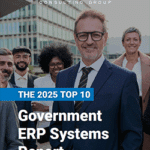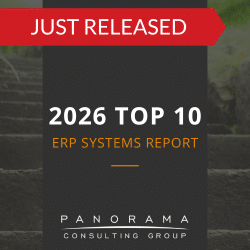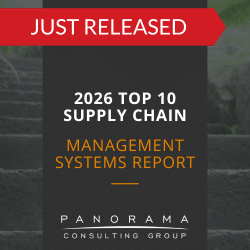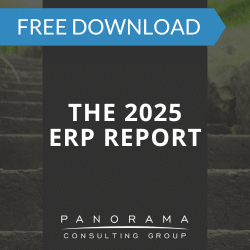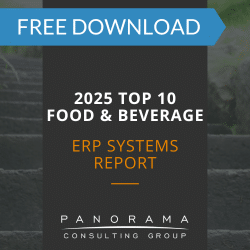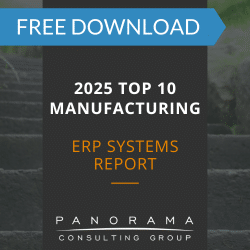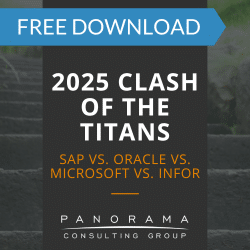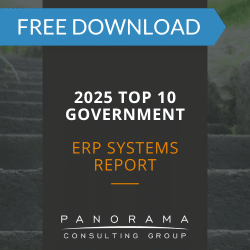Key Takeaways
- AI in ERP enhances enterprise visibility by combining machine learning, predictive analytics, and automation to improve forecasting, reporting, and operational efficiency.
- AI in ERP systems transforms traditional workflows by enabling decision support, and adaptive process optimization across business functions.
- AI-powered ERP platforms integrate co-pilot features and predictive modeling to enable more data-driven operations.
- AI enablement depends on clean data, strong governance, and ongoing change management.
As more ERP vendors integrate artificial intelligence (AI) into their platforms, organizations are finding that AI-based ERP brings both benefits and challenges.
When implemented successfully, AI in ERP can surface intelligent insights that inform supplier relationships, product development, workforce planning, and customer interactions. When implemented without the right data foundation or governance, the result is inaccurate outputs and increased compliance risk.
This guide outlines the types of AI in ERP systems, the operational and software risks, and some use cases with real-world examples.
Types of AI in ERP Software
Modern ERP systems increasingly include natural language processing, predictive analytics, and intelligent automation to help users query data, detect trends, and act on insights.
While some organizations integrate AI into their existing ERP systems, others implement ERP platforms with built-in AI functionality. The right approach depends on your current architecture, data maturity, and readiness for change.
Ultimately, your industry needs and operational realities will determine how you apply AI within your ERP environment.
For instance, a food and beverage company may add predictive maintenance and demand forecasting tools to its existing on-premise manufacturing ERP system, while a fast-growing SaaS company might adopt a cloud ERP with embedded AI to automate billing and customer analytics.
AI in ERP Examples
- Detecting irregularities in financial transactions across the ERP ledger.
- Predicting equipment failures and automating preventive maintenance scheduling.
- Automating time-consuming tasks like invoice processing, purchase-order approval, and closing routines.
- Optimizing supply chains via real-time demand forecasting, inventory recommendations and route optimization.
- Automating compliance-monitoring and regulatory-reporting processes.
- Summarizing large volumes of ERP and external data into executive dashboards and natural-language insights.
- Simulating financial, operational or market scenarios (what-if modeling) and generating adaptive forecasts based on potential changes (economic, policy, supply-chain disruptions).
Note: Some of these are more mature than others. In 2025, “co-pilot” style use-cases (assistive) are more common than fully autonomous ones.
The Risks of Using AI in Business
AI should augment, not replace, decision-making. Human oversight remains central, especially when using AI in business contexts.
Even with quality data, organizations face several risks when using AI in ERP:
Hallucinations
AI models may generate inaccurate or entirely fabricated information that appears plausible at first glance. In a business context, this could lead to faulty financial forecasts, misinterpreted compliance data, or incorrect maintenance predictions.
Continuous validation, human-in-the-loop oversight, and AI risk management controls are essential to detect hallucinations before they impact operations.
Bias
Unchecked training data can produce biased or inconsistent outputs that reinforce existing inequalities and distort performance metrics. Because many ERP systems integrate historical business data, legacy bias can seep into AI-generated insights.
For instance, historical purchasing data might favor specific vendors, causing procurement managers to concentrate spending with a limited supplier base and overlook more competitive or diverse alternatives.
Effective bias mitigation requires regular model audits, diversified data sources, and transparent documentation of data lineage to help users interpret results.
Security & Governance
As AI tools gain access to vast quantities of ERP data, they expand the organization’s attack surface and compliance exposure. Without strong governance, sensitive data, like supplier contracts or payroll information, can become accessible through AI queries or integrations.
AI governance frameworks must include role-based access controls and explicit AI usage policies, ensuring alignment with regulatory standards and internal compliance requirements.
Following the Crowd
The strong push toward “agentic” and “autonomous” AI in ERP can mislead organizations about the value their specific organization will realize. Value realization depends on your data maturity, process readiness, and governance discipline.
For example, poor data hygiene leads to unreliable AI models, reputational harm, and low value realization.
How to Ensure AI Readiness
Digital transformation success depends on more than technology. Our AI readiness consultants recommend the following best practices for sustainable AI enablement:
Data Readiness
Your ERP backbone must feed accurate and standardized data into AI systems. This requires cleansing historical records, establishing data ownership, and defining metadata standards that ensure traceability.
For example, a manufacturing company might pause its ERP rollout to cleanse and restructure its product master data, bill of materials, and quality-control records. This would ensure predictive maintenance and supply chain forecasting models are trained on accurate, up-to-date data.
Modern Architecture
Cloud-native, modular, and extensible systems dramatically improve AI enablement.
Organizations should evaluate whether their current ERP infrastructure supports API-driven integrations, real-time analytics, and scalable environments for model training. This allows faster experimentation, testing, and incremental upgrades without major disruption.
Governance & Ethics
Policies around data access, AI model usage, model monitoring, transparency, and risk management must be codified. Establishing an AI governance council or cross-functional oversight team can help monitor ethical risks, manage data lineage, and ensure alignment with organizational values. This team can also help establish ethical guardrails addressing explainability, auditability, and accountability.
Phased Adoption
The path to AI maturity is incremental. This approach reduces disruption, builds trust among users, and allows teams to refine governance protocols as complexity grows.
Our ERP selection consultants often advise organizations to begin with assistive co-pilot use cases that deliver measurable value, then scale gradually to predictive and generative applications.
Generative AI, while promising, requires robust governance and clearly defined use cases to ensure outputs are relevant, secure, and aligned with business objectives.
Change Management & Training
Training employees on new workflows and reinforcing a culture of human/machine collaboration ensures that AI adoption strengthens — rather than replaces — organizational intelligence.
We recommend upskilling employees in data literacy, AI decision support, and ethical use so they can tailor AI prompts and interpret AI recommendations effectively.
Learn More About AI-Powered ERP
AI-enabled ERP systems are transforming finance, HR, supply-chain, and customer service operations. Yet, many organizations rush into AI without the readiness required for sustained value.
Our group of ERP advisors can assess your current state and determine if and when AI integration is feasible. Contact us below for an ERP consultation.


